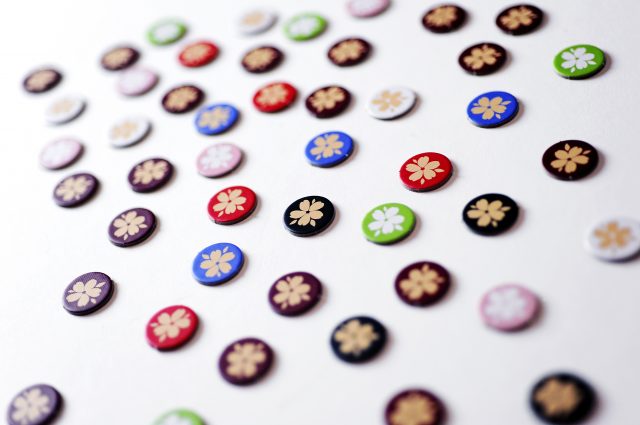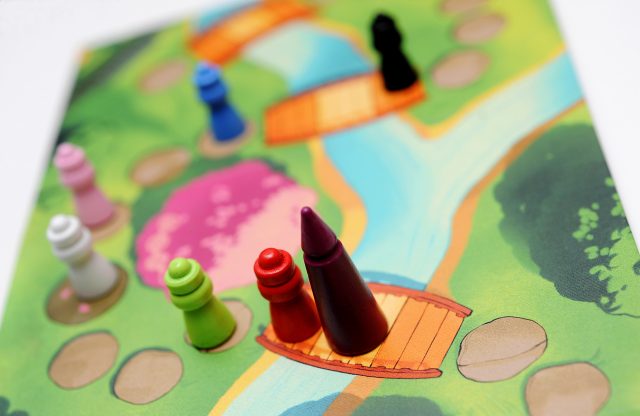Spring is that time of year when everything is in full bloom and inspiration is everywhere. What could be more inspiring than his excellency, the Emperor taking in the cherry blossom trees, full of beauty and colour. Every year he takes a walk among the trees, and every year a cadre of painters follows in close pursuit in an effort to find the perfect angle and paint a portrait for the ages.
 In Sakura, two to six players control Painters following the Emperor through a garden path. He will stop three times on Sakura spaces to observe the beautiful pink foliage of the cherry trees. At each of these moments in the game, a scoring takes place. The closer your artist is to the Emperor, the more points you will receive. However, if in your eagerness to stay close to the Emperor, you should make the ultimate faux pas and bump into him, you will be knocked back three spaces and lose a point. It is a delicate balance that each painter must walk.
In Sakura, two to six players control Painters following the Emperor through a garden path. He will stop three times on Sakura spaces to observe the beautiful pink foliage of the cherry trees. At each of these moments in the game, a scoring takes place. The closer your artist is to the Emperor, the more points you will receive. However, if in your eagerness to stay close to the Emperor, you should make the ultimate faux pas and bump into him, you will be knocked back three spaces and lose a point. It is a delicate balance that each painter must walk.
Sakura is the new game from Reiner Knizia, published by Osprey Games. Knizia is most famous for his earlier titles including Ra, Tigris and Euphrates, Modern Art, and Lost Cities. In more recent years, his games have been met with a more lukewarm reception, but seeing his name on a box cover should be enough to peak a game fan’s interest at least.
 The gameplay in Sakura is driven by beautifully illustrated cards, which contain a Garden Action, a Painter Action, and an Order Number (between 1-60). Both the Garden and Painter Actions will affect the state of the people in the garden. Usually the Garden action will move the Emperor, but sometimes, it will allow you to move the Painter closest or Furthest from the Emperor. The Painter action will allow you to move your Painter forward or backward. The Order number determines when the Actions on your card will go off.
The gameplay in Sakura is driven by beautifully illustrated cards, which contain a Garden Action, a Painter Action, and an Order Number (between 1-60). Both the Garden and Painter Actions will affect the state of the people in the garden. Usually the Garden action will move the Emperor, but sometimes, it will allow you to move the Painter closest or Furthest from the Emperor. The Painter action will allow you to move your Painter forward or backward. The Order number determines when the Actions on your card will go off.
Sakura plays out like a push your luck game. Each painter starts at the Garden Gates, the Emperor has already entered and starts a few spaces ahead of the crowd of adoring artisans. Players have a hand of five cards and simultaneously choose one, then reveal it at the same time. The actions on the cards are executed based on the Order numbers. The higher the number, the later the round your card is executed. As the Painters move around the Garden, they will jostle for position. Moving forward or backwards, they’ll only count open spaces, meaning big gains or losses are possible when the field is crowded.
Most of the Painter actions allow you to move forward or backward, by a set number of spaces, but some depend on the layout. One allows you to move forward as many spaces as there are Painters in front of you, so it can be good to be further behind. Another allows you to leapfrog the player directly ahead of you, but if there are a bunch of people in a clump, you can gain several spots at once.
Depending on the layout of the board, going sooner or later can be advantageous. You have to predict both, what other people are going to play, and when your card is going to hit. You want to stay as close to the Emperor as you can, but misjudge where he’ll end up, or leave yourself too close and you might end up running right in to him. Oh, the embarrassment!
 The goal of the game is Tokens. Each Painter starts with five of their own colour, but that’s not going to impress anyone. Each time the Emperor hits a Sakura space on the board, Tokens will be awarded based on how close the painters are, and thusly, how beautiful their paintings are. After the Tokens are awarded, all of the Painters move up, so that they are all in a line with no spaces in between them. Rounds continue until the last Sakura space is reached by the Emperor. There is a final scoring and the best Painter is declared.
The goal of the game is Tokens. Each Painter starts with five of their own colour, but that’s not going to impress anyone. Each time the Emperor hits a Sakura space on the board, Tokens will be awarded based on how close the painters are, and thusly, how beautiful their paintings are. After the Tokens are awarded, all of the Painters move up, so that they are all in a line with no spaces in between them. Rounds continue until the last Sakura space is reached by the Emperor. There is a final scoring and the best Painter is declared.
Sakura is an interesting game, although it’s definitely not one for people who aren’t fans of chaos. Especially with high player counts, it can be next to impossible to determine how the card you choose will affect your position. The earlier you go, the more control you have, but by the end of the round, you have no idea how things might have shifted. And really that’s kind of the fun of this type of game. You want to be close to the Emperor to capture his likeness perfectly, but too close and you’ll pay the price.
 I would be remiss if I didn’t mention the beautiful art and design of this game. From the thick cards with beautiful backs and illustrations that look like they were taken from an unknown Studio Ghibli movie, to the long, narrow Garden board, and the cute, little Painter and Emperor pawns. Everything is just pretty. Osprey Games and artist Kevin Hong have put together a good looking package.
I would be remiss if I didn’t mention the beautiful art and design of this game. From the thick cards with beautiful backs and illustrations that look like they were taken from an unknown Studio Ghibli movie, to the long, narrow Garden board, and the cute, little Painter and Emperor pawns. Everything is just pretty. Osprey Games and artist Kevin Hong have put together a good looking package.
There are variants for less players, but really this game is going to shine the more people you have fighting for position. But now for the big question, is it a good game? Sakura is going to be a great game for some people, for me, it’s a fun enough distraction, that doesn’t take too much time to play. It’s not a return to the good Dr. Knizia’s glory days, but it’s not a bad introduction for people new to his games and it looks mighty fine too.
—
A review copy of Sakura was provided for this article by Osprey Games.
Comments
No comments yet! Be the first!